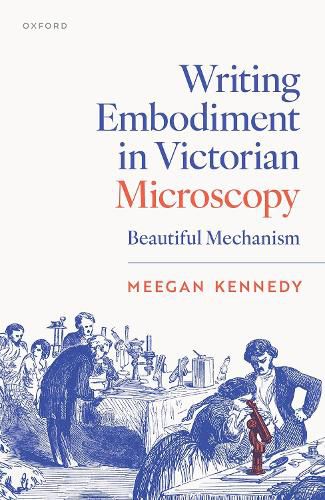Readings Newsletter
Become a Readings Member to make your shopping experience even easier.
Sign in or sign up for free!
You’re not far away from qualifying for FREE standard shipping within Australia
You’ve qualified for FREE standard shipping within Australia
The cart is loading…






Writing Embodiment in Victorian Microscopy examines a revolutionary period in microscopical technology and practice. At first considered a mere toy, by 1900 the microscope rivaled the railway and telegraph as an emblem of modernity and enjoyed an astonishing diversity of applications. This technology could drive scientific debates on subjects like cell theory, vitalism, and bacteriology; guide workers in classrooms, laboratories, and businesses; and inspire a personal hobby or a mass entertainment. Victorian microscopy productively cuts across the ostensibly separate domains of science, religion, commerce, art, education, entertainment, and domestic life. Writing Embodiment reads nineteenth-century microscopy across scientific, literary, religious, and popular texts. It argues that Victorian microscopists saw their vision and cognition as fully embodied experiences, the images emerging through a material entanglement of bodies (observer, instrument, apparatus, object) in a dynamic, unstable system. These ideas echo the work of physiological psychologists, who proposed mind as a system of embodied, distributed, and dynamic processes shaped by automatic or unconscious reflex action, attention, mental training, and fatigue. Striving to regulate this complex system, microscopists circulated tropes of embodiment through the varied forms of nineteenth-century print culture. They adapted existing concepts (such as beauty, the sublime, natural theology, and fairylands), or coined new phrases (such as many-sided comprehension), to promote favored forms of embodiment and enculturate microscopy as a difficult but valuable pursuit. Beautiful Mechanism draws on important work in book history and periodical studies by emphasizing the circulation of these tropes in intermedial conversations across diverse print forms. Victorians understood wonder and skepticism not as incommensurate approaches to scientific observation but rather as complementary forms of embodiment. Romantic tropes of wonder solicit affective flows from observer to wriggling animalcule and back; while skeptical, realist tropes offer to train the reader's eye, hand, body, and judgment and to formalize microscopical practice. Microscopical narratives may manipulate wonder and skepticism in productive tension or create virtual storyspaces that enlist the reader in virtual witnessing. These tropes shape every level of microscopical interest and proficiency. By analyzing their use and circulation, Writing Embodiment illuminates wider patterns of Victorian thought on embodiment, scientific practice, and community.
$9.00 standard shipping within Australia
FREE standard shipping within Australia for orders over $100.00
Express & International shipping calculated at checkout
Writing Embodiment in Victorian Microscopy examines a revolutionary period in microscopical technology and practice. At first considered a mere toy, by 1900 the microscope rivaled the railway and telegraph as an emblem of modernity and enjoyed an astonishing diversity of applications. This technology could drive scientific debates on subjects like cell theory, vitalism, and bacteriology; guide workers in classrooms, laboratories, and businesses; and inspire a personal hobby or a mass entertainment. Victorian microscopy productively cuts across the ostensibly separate domains of science, religion, commerce, art, education, entertainment, and domestic life. Writing Embodiment reads nineteenth-century microscopy across scientific, literary, religious, and popular texts. It argues that Victorian microscopists saw their vision and cognition as fully embodied experiences, the images emerging through a material entanglement of bodies (observer, instrument, apparatus, object) in a dynamic, unstable system. These ideas echo the work of physiological psychologists, who proposed mind as a system of embodied, distributed, and dynamic processes shaped by automatic or unconscious reflex action, attention, mental training, and fatigue. Striving to regulate this complex system, microscopists circulated tropes of embodiment through the varied forms of nineteenth-century print culture. They adapted existing concepts (such as beauty, the sublime, natural theology, and fairylands), or coined new phrases (such as many-sided comprehension), to promote favored forms of embodiment and enculturate microscopy as a difficult but valuable pursuit. Beautiful Mechanism draws on important work in book history and periodical studies by emphasizing the circulation of these tropes in intermedial conversations across diverse print forms. Victorians understood wonder and skepticism not as incommensurate approaches to scientific observation but rather as complementary forms of embodiment. Romantic tropes of wonder solicit affective flows from observer to wriggling animalcule and back; while skeptical, realist tropes offer to train the reader's eye, hand, body, and judgment and to formalize microscopical practice. Microscopical narratives may manipulate wonder and skepticism in productive tension or create virtual storyspaces that enlist the reader in virtual witnessing. These tropes shape every level of microscopical interest and proficiency. By analyzing their use and circulation, Writing Embodiment illuminates wider patterns of Victorian thought on embodiment, scientific practice, and community.